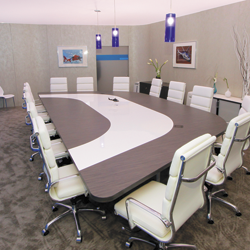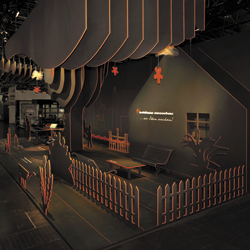|
REGISTRATION REQUIRED
insight

Mitchell Mauk is the creative genius behind Mauk Design, a firm he started in 1986 when he began to crave freedom and the permission to dream bigger than the small agencies he worked for allowed. Mauk Design has designed hundreds of environments for organizations, many of which he calls dream clients. Some of these dream clients are big in name, such as Apple, McDonald's, and Play Station, but Mauk says all it takes to be a dream client is the right attitude – that is, an expansive vision and trust in the creative process.
PHOTOS: Andy Caulfield; Mitchell Mauk
Making a Mauk
Mitchell Mauk's inspired and insightful work earned him the Lifetime Achievement award at EXHIBITORLIVE 2023, but he still has a long span of creativity ahead of him. We sat down with Mauk to talk about what led him to this moment, what his future holds, and what lessons he picked up
along the way.
Although Mitchell Mauk has worked with plenty of dream clients, Exhibitor Group asserts that the real dream is working with Mauk, which is why he
was awarded the Lifetime Achievement Award at EXHIBITORLIVE 2023 in Louisville. The award was a surprise to Mauk. "My first reaction was gratitude to the group for recognizing me like that," he said after the presentation. "And my second reaction was, 'I'm too young for this!'"
Indeed Mauk has no intention of slowing down and has a years-long career in front of him. "I've had the opportunity to work with some really great clients and fabricators over the years," he said. "And I'm always on the lookout for the next great project that I can knock out of the park." Following the award ceremony, but before his next great project, EXHIBITOR magazine took the opportunity to sit down with Mauk and chat about his career. EXHIBITOR Magazine: How did you get into exhibit design? Mitchell Mauk: I had always done a lot of model making through junior high and high school. I had five years of wood shop and four years of metal shop. I even built stuff out of wood in kindergarten. So I came out of school knowing how to build. When I got to college, I learned the communication aspect of art. Also the graphics people always had three-dimensional projects, and I became their go-to person. At one of my first jobs, I had designed half a dozen exhibits before I even went to a trade show. EM: Do you consider yourself an artist? MM: I do. The art comes out in different ways. It could be an exhibit or a logo or furniture. Herman Miller once hired me to do advanced furniture design. The designer Massimo Vignelli said a great designer ought to be able to design anything, and that has been a guideline for me for my whole career. You don't know what you can do until you try. EM: It seems you can do a lot! And that speaks to the many types of projects you've tried in your career. Can you explain how you enter the creative flow when starting a new project? MM: A lot of times it hits you like lightning. The hours after you get direction from a client can be a really creative time. Sometimes I sit in a taxi after a meeting and just let the creativity wash over me. And invariably, I have to ask myself not, "What am I going to present?" but, "Which one am I going to present?" EM: How do you choose? MM: I consider which idea communicates a message most powerfully in service of the client's business goals. EM: Of course you're hired to help a client reach their business goals. But you're an artist. Does serving commerce run counter to an artist's sensibilities? MM: Walking that line is key to this work. I'm not a fine artist.Fine art has its own strictures. My mandate is to get as much creativity as possible into the business. Exhibit design is a fascinating confluence of architecture, marketing, and furniture moving. Of course, you have to think about how the exhibit gets in and gets out and how much it costs. But when I'm designing an environment, I think less about filling the space and more about filling the mind. What idea does the attendee walk away with? If you design an exhibit, you can end up with something that looks similar to the exhibit next door. So I don't design exhibits. I design communication. Because when you design a message, that's when things get exciting. Real creativity happens by letting the message drive the look of the exhibit environment.
EM: I imagine your clients have some idea of what that message has to look like. Do they ever come to you with an idea already firmly solidified in their mind?
MM: The request for proposal (RFP) tells me a lot, not only about a project but about the client's philosophy. I steer away from RFPs that are written so tightly that there's only one solution. Having enough latitude in what the design might end up being is really important. Sometimes I can read an RFP and think, "I know how to do this in a way nobody else would think of." And sometimes I go into it knowing that not only do I know what to do, I know how to enable what the client has in mind but hasn't said explicitly. It's as Michelangelo said: You free the sculpture from the block of marble. I give ideas life. EM: You've worked with and encountered myriad talented artists and designers throughout your career. Can you name a few who have inspired you? MM: I always try to learn from great designers. They're my heroes. Saul Bass was the master of corporate identity and he gave me my first job. Charles and Ray Eames inspired me as all around designers. While everyone knows their furniture, they basically invented the multimedia presentation and designed groundbreaking exhibits – Mathematica and The World of Franklin & Jefferson. Michael Vanderbyl is a San Francisco designer who has been an exceptional mentor to me. His posters for Exhibitor Show are whimsical, human, and yet perfectly on target. His showrooms defined what a furniture showroom experience could be. These were the people who really inspired me at the beginning and throughout my career. EM: Despite this Lifetime Achievement Award, you have another lifetime of work ahead. But you've been in the industry long enough to see some evolution. What stands out to you? MM: Exhibits have gotten lighter. Transitioning from plywood to foam core to fabric has been big. Fabric-wrapped aluminum is now being used in place of hard structures. And now, video is getting more pervasive. It's basically becoming video wallpaper with every surface covered. But if everyone has it, how do you stand out? I don't use video just to use it. I consider the reason for using it. What should it communicate? If it's just a moving wall, a customer may walk away from the exhibit with no idea what the message was. As soon as I see a trend, I want to go in some other direction. If it's a trend, it's been done before. And I want to do something that's never been done before.
EM: I'm sure this hasn't happened often, but it does happen to the best of us. Have you ever experienced failure when trying to do something that's never been tried?
MM: Very early in my career, I was designing a 30-by-30-foot peninsula exhibit. I'm a graphics person and love big typography, so I did a 30-foot-long logotype that punched through the wall. Show attendees could walk through the letters into the exhibit. Before the show opened, the client was very happy. But after the show opened, the client said, "Nobody knows who we are because they can't back up far enough into the aisle to read the company name." From that experience I learned that you have to design in context. EM: Of all your many designs, is there one in particular that stands out as a favorite? MM: The Duncan Aviation exhibits are my favorite. We came up with a single message, which was that their people are their key to success. The first exhibit I did for them had 350 employee signatures from every employee in the company. The second had 700 employee photographs. For the third exhibit, Duncan Aviation had over 2,000 employ-ees, and we needed to install their portraits overhead. For the fourth exhibit, we had video of every employee in the company. And over the course of decades, we communicated this single idea. It's been wonderful to watch this small company grow into the largest family-owned MRO in the aviation industry and to be part of communicating its growth. EM: A lot of young designers are entering the workforce and exhibit industry. What advice would you give them to find the kind of success you've experienced? MM: Here are a couple of thoughts. First, be aware that the future is coming at you faster and faster. Hunt down new technologies and things that bring human delight. Look for ideas off the show floor. Fashion shows, museums, newspapers, furniture, World's Fairs, tractor pulls – anything that communicates an idea. Also I think to go forward into this future, be aware of the past. There were fantastic exhibits done in the 1900s that still look good today. The past has amazing design that can inspire far into the future. E
|
|
|
||||||||||||||||||||||||||||
|
|
||||||||||||||||||||||||||||
|
TOPICS Measurement & Budgeting Planning & Execution Marketing & Promotion Events & Venues Personal & Career Exhibits & Experiences International Exhibiting Resources for Rookies Research & Resources |
MAGAZINE Subscribe Today! Renew Subscription Update Address Digital Downloads Newsletters Advertise |
FIND IT Exhibit Producers Products & Services All Companies Get Listed |
EXHIBITORLIVE Sessions Exhibit Hall Exhibit at the Show Registration |
ETRAK Sessions Certification F.A.Q. Registration |
EDUCATION WEEK Overview Sessions Hotel Registration |
CERTIFICATION The Program Steps to Certification Faculty and Staff Enroll in CTSM Submit Quiz Answers My CTSM |
AWARDS Exhibit Design Awards Portable/Modular Awards Corporate Event Awards Centers of Excellence |
NEWS Associations/Press Awards Company News International New Products People Shows & Events Venues & Destinations EXHIBITOR News |
||||||||||||||||||||
|
||||||||||||||||||||||||||||











